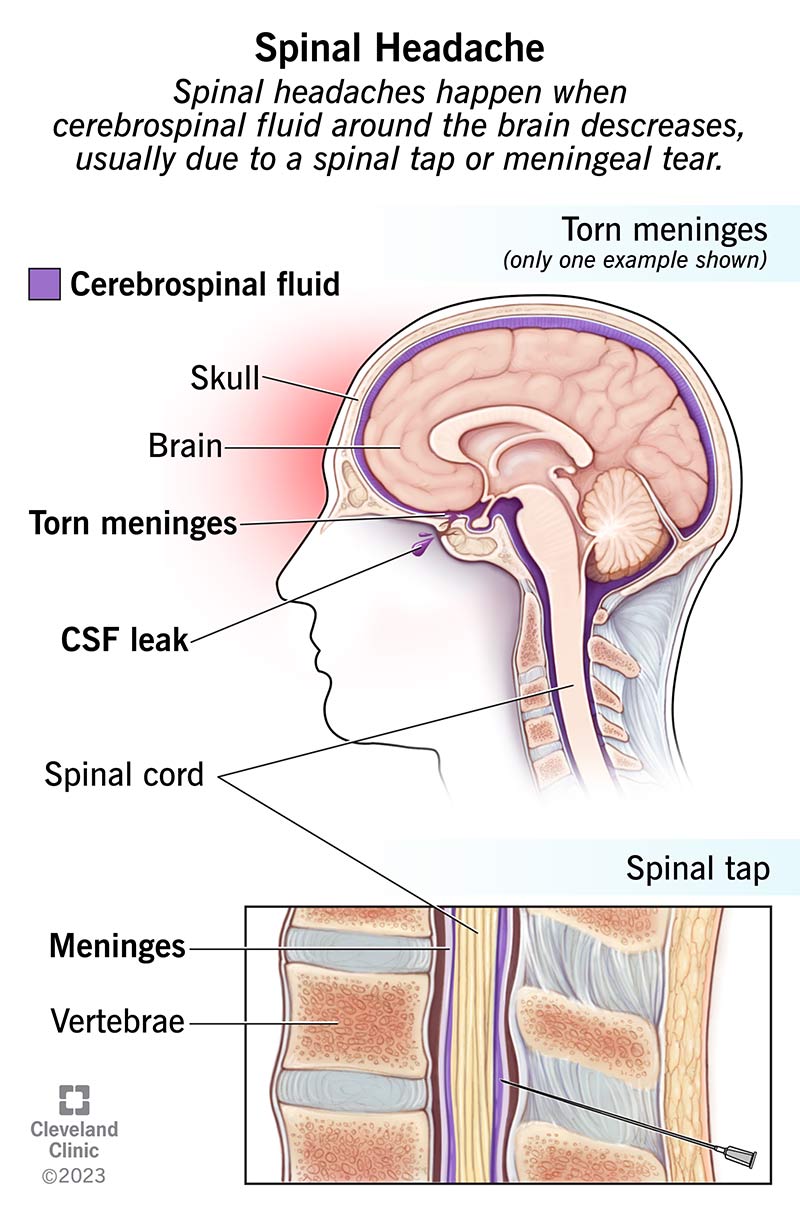A spinal headache is an intense headache that can result from a spinal tap (lumbar puncture), like an epidural. It happens when cerebrospinal fluid leaks out. Spinal headaches usually go away on their own. But some cases require an epidural blood patch.
Advertisement
Cleveland Clinic is a non-profit academic medical center. Advertising on our site helps support our mission. We do not endorse non-Cleveland Clinic products or services. Policy

Image content: This image is available to view online.
View image online (https://my.clevelandclinic.org/-/scassets/images/org/health/articles/17927-spinal-headaches-1)
A spinal headache is an intense headache that happens when the amount of cerebrospinal fluid (CSF) around your brain decreases. It can result from a spinal tap (lumbar puncture) or if CSF leaks out due to a cyst or tear in the meninges that cover your spinal cord.
Advertisement
Cleveland Clinic is a non-profit academic medical center. Advertising on our site helps support our mission. We do not endorse non-Cleveland Clinic products or services. Policy
Your brain and spinal cord have a surrounding protective layer of CSF. It contains nutrients that your brain can use. The CSF layer also supports and cushions your brain and spinal cord from sudden movements.
A leakage of CSF reduces the amount of fluid around your brain. The leakage can cause the tissues and nerves that support your brain to stretch, resulting in headache pain.
Spinal headaches are also known by the following names:
Studies show that a spinal headache develops in approximately 10% to 40% of lumbar puncture procedures.
Symptoms of a spinal headache typically develop within two to three days of a spinal tap. But they can also develop months afterward.
Symptoms of a spinal headache include:
Less common symptoms include:
Advertisement
Spinal headaches typically last from a few hours to a few days, but can last longer. See your healthcare provider if your symptoms continue for more than 24 hours.
The most common cause of a spinal headache is a puncture (hole) created during a spinal tap or lumbar puncture. Healthcare providers perform spinal taps to diagnose certain conditions and to deliver anesthesia, like when you have an epidural during labor and delivery.
During a lumbar puncture, a provider inserts a needle into your spinal canal in your lower back to deliver anesthesia or withdraw a sample of cerebrospinal fluid. Sometimes, spinal fluid leaks out of this tiny hole.
The loss of fluid results in low CSF pressure around your brain (intracranial hypotension). This causes your brain to sag downward. The surrounding nerves and tissues become stretched, which results in a headache.
Other conditions can cause spinal fluid leaks that lead to spinal headaches, including:
Risk factors for spinal headaches include:
Spinal headaches are most common in 20-to-40-year-olds who receive epidurals during labor.
A healthcare provider diagnoses a spinal headache based on your history and symptoms. If you’ve had a spinal tap in the last 14 days, the diagnosis is often obvious. In that case, you usually don’t need tests.
If you haven’t had a spinal tap, providers typically use magnetic resonance imaging (MRI) to diagnose the source of the headache. This imaging test allows your provider to see your brain and spinal cord to look for signs of leaking cerebrospinal fluid.
To manage most spinal headaches, healthcare providers recommend:
Sometimes, these measures don’t relieve the pain. If a spinal headache lasts more than a few days, your provider may recommend an epidural blood patch. During this procedure, a provider injects a small amount of your blood over the hole that’s leaking CSF. When the blood clots, it seals the hole.
In rare cases, providers use surgery to seal the hole where spinal fluid is leaking.
The prognosis (outlook) for a spinal headache is generally good. About 85% of all spinal headaches get better without treatment. About 60% to 70% of people who have an epidural blood patch no longer have a spinal headache within 24 hours.
Advertisement
In rare cases, prolonged or severe spinal headaches can lead to the following complications:
There’s generally nothing you can do to prevent a spinal headache. Healthcare providers can reduce the risk of a spinal headache developing by performing a spinal tap using a small needle called a non-cutting needle.
Contact your healthcare provider if you experience a severe headache after a spinal tap, especially if it lasts longer than 24 hours. Get immediate medical attention if you experience difficulty peeing or lose feeling in your back or legs. These are signs of serious complications.
Everyone gets headaches from time to time for various reasons. But spinal headaches aren’t ordinary headaches. If you experience a severe headache after getting a spinal tap or epidural, tell your healthcare provider. While most spinal headaches go away on their own, you might need an epidural blood patch to treat it.
Advertisement
Learn more about the Health Library and our editorial process.
Cleveland Clinic's health articles are based on evidence-backed information and review by medical professionals to ensure accuracy, reliability, and up-to-date clinical standards.
Cleveland Clinic's health articles are based on evidence-backed information and review by medical professionals to ensure accuracy, reliability, and up-to-date clinical standards.
Need care fast? Cleveland Clinic’s Express Care and Urgent Care locations treat everything from sprains to sinus infections — no appointment needed.
